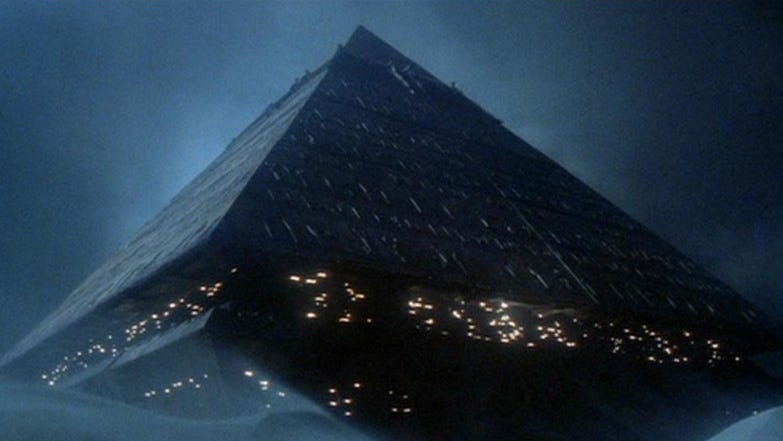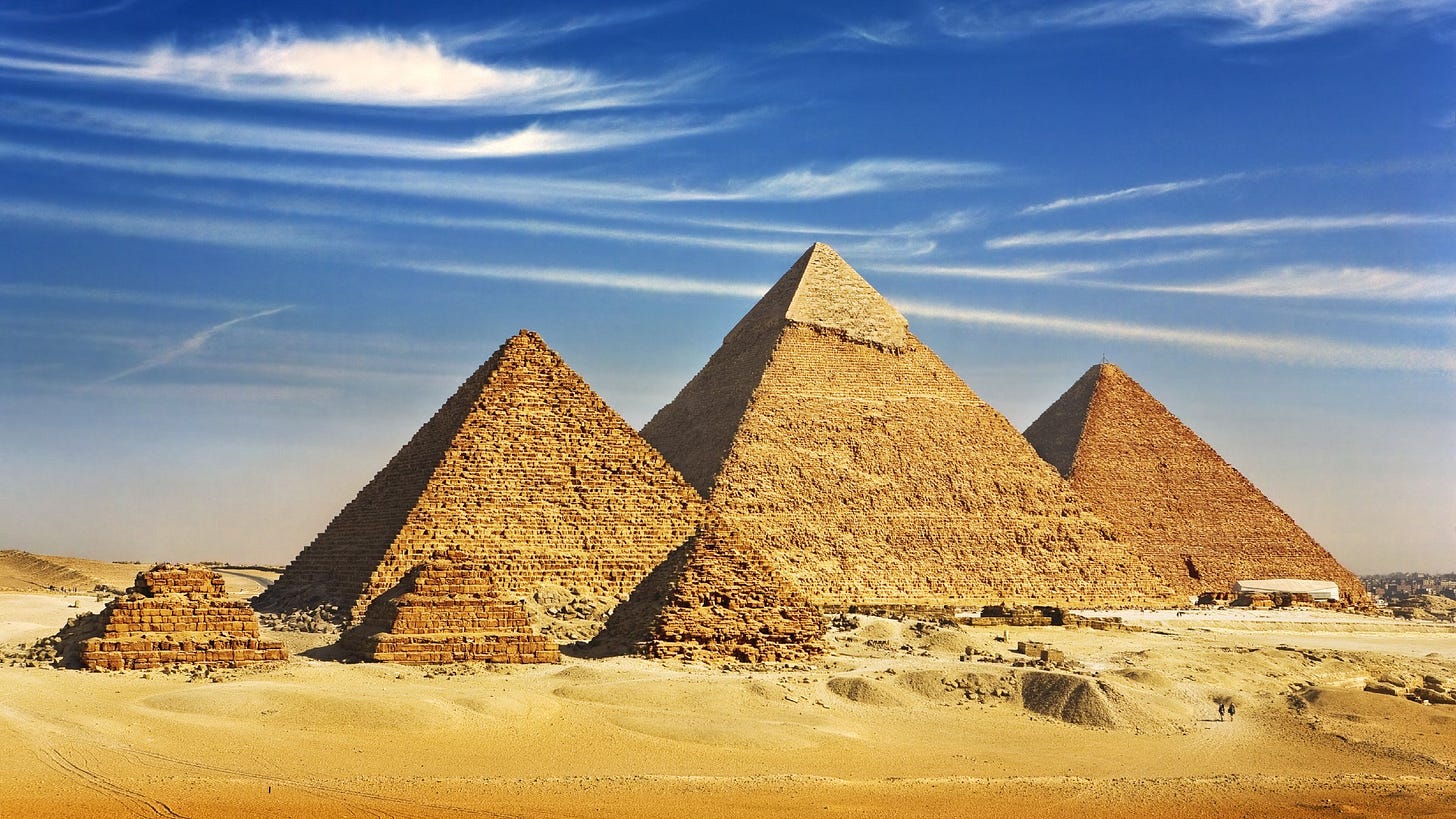Ancient Alien Linguistics, The Pyramids, and Radio Antennas
In which I discuss the incredible effort put into making Stargate's Egyptian/Alien thesis historically accurate, and William Shatner exposes the true nature of the Great Pyramid as an RF antenna.
Ancient Egypt in Unexpected Places
Turn to page three hundred and ninety-four, says Professor Snape, stalking menacingly into the Defense Against the Dark Arts classroom. It’s a strangely memorable line, due entirely to the acting talent of Alan Rickman.
Now, watch the following clip, but pay attention to the slideshow in the background.
I love this scene from Harry Potter and the Prisoner of Azkaban, because Prof. Snape’s slideshow has some really cool pictures of historical artifacts. Here’s one of an Egyptian man fighting a werewolf.
Of course, it’s not a real image, it’s actually a very well done edit of a gorgeous scene from the Tomb of Nebamun:

Look at the fantastic colors, preserved for 3400 years!
I love Ancient Egypt in movies, and I’m clearly not the only one. And so, I thought I’d write a little bit about two of my favorite cases of Ancient Egypt in media, starting with my absolute favorite, Stargate. You probably wouldn’t guess it from the premise, but the original Stargate contains some of the best, most accurate Egyptology of any film, ever.
The Brilliance of Stargate’s Linguistics
Stargate, the movie, is a touching documentary about a young James Spader’s deep, personal relationship with a mutant yak.
Okay, no, it’s actually a movie about how the Egyptian gods are aliens and the pyramids are landing platforms for pyramid-shaped spaceships, but honestly, my version is more believable.

Now you wouldn’t expect a movie with this premise to be a paragon of Egyptological correctness, but it is. Much of the credit for this should go to Prof. Stuart Smith (and, I suspect, his graduate students). He’s an Anthropology Professor at UC Santa Barbara, and was the Egyptological consultant for Stargate and The Mummy.
Let me show you an example of the depth of thought that went into Stargate. Watch this clip:
In this clip, we see Daniel Jackson translating some hieroglyphs written on the Stargate.
First he comments:
Well, the translation on the inner track is wrong. Must have used Budge, I don’t know why they keep reprinting his books.
This is an Egyptology joke! E. A. Wallis Budge was an early Egyptologist who, among other things, did a full translation of the Book of the Dead. He was considered a bit of a hack, even by Egyptologists of his time, and more modern scholars caution against using his books as reference texts.
Jackson then begins fixing the incorrect translation of the hieroglyphs on the Stargate. Here’s my transcription of the hieroglyphs:
Unlike many movies about Egypt, these are correct, meaningful sentences in Middle Egyptian, although the grammar is a bit odd. In the movie, Jackson translates this as:
“A million years into the sky as Ra, sun god, sealed and buried for all time… Stargate.”
Daniel Jackson Makes Translation Errors (maybe)
I do not completely agree with Jackson’s translation. Here’s my version.
Transliteration:
(1) rnpwt 100,000 10 ḳbḥw pw rꜥ m i̓tn
(2) m ḫtm.n.f ḳrs.f n ḏt r nḥḥ
(3) sbꜣ n sbꜣw.f
Colloquial English Translation:
It is the 100,010th year of the reign of Ra as Aten (Sun God). Behold, he has sealed and he buries his Stargate for all time.
Literal Translation With Grammar Notes:
(1) It is 100,010 years in the sky, Ra as Aten
{Note: I’m thinking rnpwt should be read as regnal years instead of the generic years, because that’s how a lot of Egyptian inscriptions start. Secondly, I don’t think pw is used that way unless it’s a demonstrative adjective, but in standard Egyptian sky doesn’t need a demonstrative.}
(2) (m?) He has sealed, he buries for all time
{Note: I cannot account for the presence of the m at the start of this line, perhaps this should be the particle mk? Additionally, it switches tense from past to present between the two verbs. Maybe the first one is a relative form or something, I don’t know.}
(3) his Gate of the Stars
{Note: Unambiguous}
Now there are a couple weird things here.
First, the grammar of this inscription is a bit odd. I think there’s at least one preposition that’s out of place (the first owl glyph of the second line in particular), though I could easily be wrong.
Second, Daniel Jackson, translates the first two words in the inscription as “million years.” This is wrong. It actually says 100,010. These are the two glyphs seen juxtaposed in the first line:
The Egyptians don’t really do multiplication by juxtaposition. Their dates are always additive, and so the combination of symbols for 100,000 and 10 means 100,010, not 1,000,000.
This is an odd choice by Prof. Smith if he was going for “a million years” because there is a specific word in Egyptian for 1,000,000.
An Aside on Egyptian Math
There’s good reason for Egyptians not to have multiplicative dates. Math in Egypt was really hard. For example, the Egyptians had an incredibly cumbersome system of doing fractions, which I’ve copy-pasted here below so you can experience the same horror I did when I first saw it.
And don’t get me started on the Egyptian mathematical system for actually doing multiplication, it’s horrifying. This article on the Rhind Mathematical Papyrus blew my mind at how complicated simple math operations were, before good mathematical notation was invented. Technology is not just machines!
Anyway, despite my squabble with the exact number of years in the inscription, the rest of Daniel Jackson’s translation is completely accurate!
Spoken Egyptian in Stargate
Not only is the written Egyptian correct, but the spoken Egyptian is correct too!
You can see some examples of it in this clip, starting at 2:45.
The Egyptian spoken by Ra and Daniel is correct Middle Egyptian, with phonetics reconstructed from its daughter language, Coptic, and a few innovations thrown in to simulate evolving in isolation for a few thousand years. Prof. Smith discusses how he constructed the Egyptian dialogue for this movie in an article on his website (Parts 1, 2, 3, 4, 5, 6 found on his website).
Not only did the filmmakers of Stargate go out of their way to have their actors speak a coherent, correct, (very) dead language, but they even added a couple modifications to simulate its in-universe isolated evolution. Maybe like ten people watching that movie even noticed. In the spirit of Maximum Effort, Minimum Reward, I applaud this.
Who Really Built the Pyramids? Drunkards, Apparently.
Okay, so we’ve established that I love the Stargate movie, and also that it has shockingly good linguistics consultants. However, what about its central claim, that aliens built the pyramids as a landing pad for pyramidal starships?
Sadly, but unsurprisingly, this is wrong. The pyramids are tombs, and the pyramid builders of the Old Kingdom were a combination of skilled artisans and laborers, probably paid in bread and beer. It’s thought that the pyramid builders were recruited during the flood season as corvée labor (labor-as-tax, basically). The wikipedia article on this isn’t the greatest, but it gets the point across. This 2012 article is better, mentioning a rivalry between two gangs of pyramid builders who worked on the pyramid of Menkaure:
Evidence from ancient Egyptian texts indicates that groups of unskilled workers on pyramid-building projects were temporarily conscripted, and worked in overlapping rotation in and out of these long-term royal projects. For example, graffiti from Giza depict the rivalry between two gangs of this period, the "Friends of Menkaure" and the "Drunkards of Menkaure".
I would totally join a gang of pyramid builders called the Drunkards of Menkaure.
The Pyramids are Clearly Antennas
Okay, but let’s say you’re a very bored graduate student with access to sophisticated simulation software. Can we think of any outlandish, sci-fi uses for the Great Pyramids that isn’t alien landing pads?
Let’s hear from one of the foremost scientific experts in the field, William Shatner.
In the (hilarious) show The UnXplained (season 1, episode 2), persons such as Andrew Collins make utterly brilliant points, such as:
This extraordinary monument contains the most profound mathematics and geometry. Now why would this be incorporated in such a structure if it was simply a tomb? There’s obviously more to this story than meets the eye.
Scintillating, Mr. Collins. Shatner continues, asking:
So could the Great Pyramid have been built for another, arguably more useful, purpose? One that would make more sense, given the size and complexity of its construction?
Tell me more!
Mr. Hugh Newman and Dr. Travis Taylor, who has two PhDs (?!) and has written a book on planetary defense during extraterrestrial invasion, answer by citing the real paper, published in the Journal of Applied Physics, Electromagnetic properties of the Great Pyramid: First multipole resonances and energy concentration. This paper investigates the Great Pyramid’s properties as an RF antenna.
Apparently, when the great pyramid is illuminated from the top by ~1.2 MHz radio waves (that’s right in the AM radio band), it acts as an antenna, sort of. This is very likely to be true, as pyramidal structures are indeed excellent at shaping electromagnetic fields. I’m actually an author on a paper that investigates pyramid-shaped diamond emitters for laser-induced electron beam emission.
Alas, Mr. Shatner and his friend Hugh Newman then postulate that the Great Pyramid’s antenna-like properties would allow it to focus seismic energy from nearby earthquakes into … radio waves, I think?

Shatner concludes by arguing that the idea that the pyramids are designed as resonators to transduce vibrations to radio waves is not that crazy, because Nikola Tesla thought of something similar!
Well, he’s convinced me. Dr. Taylor’s two PhDs are certainly serving him well.
So What Have We Learned? (Very Little)
In the grand tradition of making stuff up about Egypt, which stretches back at least to Herodotus in ~450 BC, Stargate and The UnXplained are two of the most extreme examples. Stargate, a movie where the Great Pyramid is a landing pad for alien spaceships, is a paragon of linguistic accuracy that almost no one will ever notice. The UnXplained, by contrast, is a masterclass in hilariously wrong theories of why the Great Pyramid was built, complete with actual COMSOL simulations of the Pyramids as RF antennas. I applaud them both.














